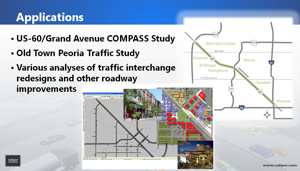| Mapping, GIS, & Transportation Software Solutions |
| Mapping, GIS, & Transportation Software Solutions |
Caliper Transportation Blog

Author: Daniel Morgan

As the focus of transportation systems management moves increasingly toward strategic management of the system’s capacity and away from building new capacity, transportation planners are faced with questions that fall outside the scope and predictive powers of conventional travel demand models. To equip planners with the means to address those questions, a number of modeling approaches and methods has been proposed. Commonly, traffic simulation and dynamic traffic assignment are among the proposed solutions. However, not so commonly is the marriage of either traffic simulation or dynamic traffic assignment (DTA) with travel demand modeling found in application. This paper outlines an approach to marry the three – traffic simulation with dynamic traffic assignment with travel demand modeling – in one framework for application to project prioritization in Central Phoenix, AZ.
The Central Phoenix study area is enclosed by Inner Loop 101 and covers more than 500 square miles and more than 1,800 signalized intersections. The model represents the first application of its kind – calibrated and validated microscopic traffic simulation and microscopic traffic simulation-based DTA for a very wide area. The model includes auto and truck travel and schedule-based bus and light rail operations on more than 90 local and express routes. The model’s calibration targets 15-minute directional and turning movement counts and its validation targets 15-minute speed data.
We present the framework in the form of a case study of Central Phoenix, highlighting the core components of the model – a microscopic traffic simulation model, a microsimulation-based DTA model, and the interface with the regional travel demand model – and detailing their calibration and validation. We trace the model development, calibration, and validation steps as a template for applying a similar framework in other cities. Lastly, we demonstrate the model’s utility in an application, simulating a future-year build-out scenario and presenting numerous performance measures.

Keywords: Microscopic traffic simulation,
planning, operations, performance measures, GIS, calibration, validation
Home | Products | Contact | Secure Store